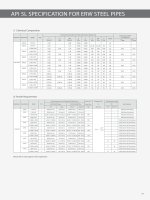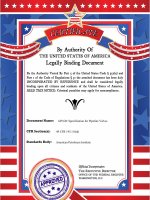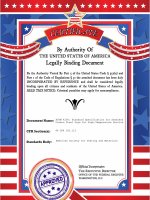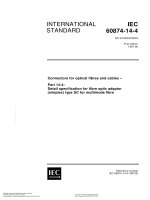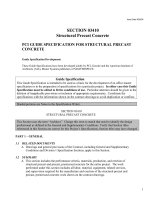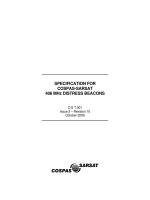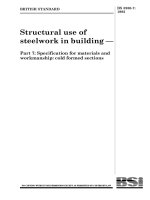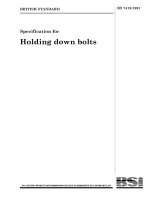ASTM D119 Specification for LowVoltage Rubber Insulating Tape
Bạn đang xem bản rút gọn của tài liệu. Xem và tải ngay bản đầy đủ của tài liệu tại đây (269.46 KB, 4 trang )
9009276 0039274 TûL =
NOTICE: This standard has either been superseded and replaced by a new version or discontinued.
9-k Contact ASTM International (www.astm.org) for the latest information.
ANSIIASTM D 119 - 78
AMERICAN SOCIETY FOR TESTING AND MATERIALS
1016 R a a St.. Phllid*lphla. Pa., 10103
Reprinted Irom lhe Annurl Book of ASTM Strndrrdr. Copyright ASTM
If not listed in the curnnt combined Index. will a w r r in the next &¡tion.
Standard Specification for
LOW-VOLTAGE RUBBER INSULATING TAPE'
This standard is issued under the fixed designation D 119; the number immediately following the designation indicates the
year of onginal adoption or,in the case of revision, the year of last revision. A number in parentheses indicates the year
of last reapproval.
This s ecification has been approved for use by agencies o f the Department of Defense and for listing in the DoD Index of
Specikaiions and Standarb.
1. scope tightly wound in rolls with a separator be-
tween layers.
1.1 This specification covers low-voltage
rubber insulating tape designed for splicing 4. Separator
electrical wires and cables operating up to
2000 volts phase to phase in dry locations 4.1 The separator shall be parchment pa-
with conductor temperatures up to 75°C per, glazed or plastic sheeting, or any suitable
(167°F) for continuous operation, to 95°C material interposed between adjacent layers.
(203°F) for emergency overload conditions, The removable or nonremovable separator
and to 150°C (302°F) for short circuit condi- shall not interfere with the use of the roll
tions. This tape is suitable for outdoor use, during application. Where a removable sepa-
but must be overwrapped to protect from rator is used, the separator shall not show any
ozone attack and from ultraviolet radiation. undue tendency to stick to the rubber or to
This tape may be applied under an ambient ravel. The outside end of the roll shall be
temperature range of -10°C (+14"F) to securely fastened.
+40°C (104°F). 5. Tensile Strength and Elongation
2. Applicable Documents 5.1 The tensile strength of the tape, when
tested as specified in Section 18 shall be not
2.1 ASTM Standards: less than 1.7 MPa (250 psi).
D 149 Tests for Dielectric Breakdown Volt-
5.2 The elongation of a 50-mm (2-in .)gage
age and Dielectric Strength of Electrical length determined simultaneously with the
Insulating Materials at Commercial tensile strength test, shall be not less than
Power Frequencies2 300 %.
D297 Chemical Analysis of Rubber Prod-
ucts3 6. Dielectric Strength
D 412 Tests for Rubber Properties in Ten- 6.1 The dielectric strength of the tape,
sion4
D 470 Testing Thermosetting Insulated and when tested as specified in Section 19, shall
Jacketed Wire and Cable5 be not less than 14 kV/mm (350 V/mil) of
thickness.
3. Compound
'This specification is under the 'urisdictjon of the
3.1 The tape shall consist of an unvulcan- ASTM Committee D-9 on Electrical jnsulating Materials
ized or partially vulcanized rubber insulating and is the direct responsibility of Subcommittee D09.18 on
compound. The compound shall contain no
more than 0.5 % of free sulfur by weight Elastomeric Insulation on Cables.
when tested as specified in Section 17. The Current edition approved Nov. 24, 1978. Published
compound shall be well, evenly and smoothly
processed, cut to the specified widths and January 1979. On 'naU published as D119-21 T.Last
previous edition D C9-A.
a Annual BooKofASTM StandardF, Part 39.
Annual Book ofASTM Srondnrdi, Part 37.
'Annual Book ofASTM Standards,Parts 37and 38.
'Annual Book ofASTM S,-
Part 40.
9007276 0039275 948 W
4CIb D 119
7. Fusion conformance to all requirements of the spec-
ification.
7.1 The tape shall meet the fusion test as
specified in Section 20. 11.4 At least 610 mm (24 in.) of the
outer layer of each sample roll shall be
8. Heat Resistance removed and discarded before taking test
specimens.
8.1 The tape shall meet the heat resistance
test as specified in Section 21. 11.5 The test specimen shall be unwound
from the roll at a slow uniform rate without
9. Dimensions
jerking .
9.1 The tape shall conform to the following
nominal dimensions when tested as specified 12. Inspection
in Section 22:
12.1 Inspection of the material shall be
Width Thickness Length made as agreed upon by the purchaser and
seller as part of the purchase contract.
mm in. mm in. m Yd
12.2 If it is required, the tape shall be
20 0.75 0.80 0.030 9.1 10 tested and inspected either at the place of
25 1.00 0.80 0.030 manufacture prior to shipment or at the
40 1.50 0.80 0.030 9.1 10 place of delivery within 4 weeks from date of
50 2.00 0.80 0.030 delivery.
9.1 10
13. Aging and Storage
9.1 10
13.1 The tape shall at any time within
Millimetre and inch values, and metre and eight months after acceptance, if properly
yard values are nominal and not equivalent. stored, meet the fusion test as specified in
Other widths, thicknesses and lengths may be Section 20, and shall not become unduly
supplied as agreed between the purchaser and attached to any removable separators.
the supplier.
13.2 Tape, to be properly stored, shall be
10. Permissible Vanations in Dimension stored in the original cartons and preferably
in a cool location. Tape shall not be stored in
10.1 The average thickness shall not vary close proximity to steam pipes, radiators, or
from the nominal thickness more than 20.08 other sources of heat.
mm (+r0.003in.) and the average width not
more than 20.08 mm (20.003 in.) and the 13.3 In unvulcanized types, the tape must
length of the rolls in any sampling shall be no release easily for application and be able to
less than the nominal length. No individual pass the fusion test of Section 20 after the
thickness shall vary from the nominal thick- roll has been aged at 40°C for 60 days. This
ness more than 2 1 3 % and no individual is a performance test and is to be conducted
width shall vary more than k 1 . 5 mm (+0.06 by the manufacturer when any change is
in .). U. S . customary units are referee. made. The manufacturer shall submit a copy
of the test results when requested by any
11. Sampling purchaser. This test is not required for par-
tially vulcanized tapes.
11.1 Sample rolls shall be taken at random
from each shipment as specified in the follow- 14. Rejection and Retests
ing table:
14.1 The purchaser reserves the right to
Number of R o b in Shipment Number of Sample Rolls reject any part of the shipment that does not
comply with Section 15.
50 to 200 2
14.2 The purchaser reserves the right to
201 to 500 3 reject a shipment from which two or more
sample rolls fail to meet the requirements of
501 to 1000 4 any individual test or measurement pre-
scribed in these specifications, without addi-
1001 t o 5000 5 tional sampling. If only one sample roll fails
For shipments in excess of 5000 rolls, one
additional roll shall be taken for each addi-
tional 1000 rolls or fraction thereof.
11.2 A shipment shall consist of material
shipped or intended for shipment to a pur-
chaser and covered by one bill of lading.
11.3 Each sample roll shall be tested for
2
~
9009276 0019276 884
4CTb D 119
an individual test a second set of samples be full width. In placing the parallel gage
shall be taken as specified in Section 11 and marks on the test specimen take care not to
all rolls in the second sampling shall be cut the stock.
subjected to that test or measurement
wherein the failure occurred. The purchaser 18.1.4 Test three specimens, free from
reserves the right to reject the shipment if visible defects, from each sample roll. Re-
the second sampling fails to conform with port the average of the three tests.
the applicable requirement.
19. Dielectric Strength Test
14.3 The manufacturer shall replace re-
jected tape and shall pay freight charges for 19.1 Determine the dielectric strength by
the return of such material. placing a specimen approximately 150 mm
(6 in.) in length between two flat electrodes
15. Packaging and Marking 6.4 mm (0.25 in.) in width by 108 mm (4.25
in.) in length with edges square and ends
15.1 Each roll of tape shall be enclosed in rounded to 3.2-mm (0,125-in.) radius (see
a paper carton, unless otherwise specified. If Fig. 1). The area of contact with the surface
enclosed in a carton, either the roll of tape of the tape specimen is 6.4 mm (0.25 in.) in
shall be wrapped in a moisture-proof mate- width by 100 mm (4 in.) in length. Under an
rial, or the carton shall be wrapped in a electrode pressure of 7 kPa (1 psi), apply a
moisture-proof material and sealed. The 60-Hz voltage with a sine wave form as
wrapping of the tape or carton shall be specified in 5.1 of Method D 149, at a value
secure and shall protect the contents fully. less than 1000 V and raise it at the rate of
500 V/s until puncture occurs. In order to
15.2 Each carton shall be marked with prevent flashover, one may secure increased
the name of the manufacturer or trade mark, width by attaching to each side of the test
the month and year of manufacture, and the specimen an added piece of tape, making a
nominal width, thickness, and length of the 3-mm (0.125-in.) lap seam carefully rolled
tape. down. Other suitable means may be used
such as sampling and testing from the master
TEST METHODS roll.
16. Room Temperure 20. Fusion Test
16.1 The temperature of the room in 20.1 Spirally wrap a piece of tape while
which the tensile strength, elongation, and elongated to 200 2 20 % of its original
fusion tests are made shall be 23 k2"C (73.4 length for a distance of approximately 150
I3.6"F). mm (6 in.) around an Awg size 8 wire in
such a manner that except for the ends, the
17. Free Sulfur Test tape shall be four layers deep. Affix the end
of the tape to make a lap splice with the
17.1 A chemical analysis for free sulfur underlying tape and roll the specimen so
shall be made as specified in Section 28 of formed between the palms of the hand.
Method D 297. Condition the specimen at a temperature of
23 I2°C (73.4 iz 3.6"F) for a period of 24
18. Tensile Strength and Elongation Tests h.
18.l Perform the tests for tensile strength 20.2 The fused tape shall not show any
and elongation as specified in Method D 412, evidence of unwinding or flagging.
with the following exceptions:
21. Heat Resisỵance Test
18.1.1 The room temperature shall be as
specified in Section 16. 21.1 Specimens shall be prepared as fol-
lows: Butt-wrap the tape around a 50 to 75-
18.1.2 Cut the test specimens from a sin- mm (2 to 3-in.) mandrel, for a distance of
gle-ply sample. 125 to 150 mm (5 to 6 in.), with minimum
elongation, taking care to reduce air space
18.1.3 Use the dumbbell-shaped test
specimen and cut with the ASTM standard
die as shown in Fig. 1 (Die A) of Method
D 412, except that the ends of the specimen
cut from a 20-mm (0.75-in.) tape need not
. , 3 ':-.-;.*..
.: .-'., r,: I ..
7009276 0039277 710 =
4Cb D 119
between the adjacent layers to a minimum. graduated to 0.02 mm (0.001 in.) and having
Build the specimen to a four layer thickness a presser foot 6.35 f 0.25 mm (0.25 i 0.01
by applying the tape smoothly and evenly, in.) in diameter, exerting a total force of 2.5
maintaining a 50 % overlay. Support the 2 0.03 N (10 A 0.1 ozf). Apply the load by
entire assembly in a circulating air oven for 7 means of a weight. Determine the thickness
of the separator in a similar manner. Con-
days at 95°C (203°F). sider the thickness of the separator sub-
tracted from the thickness of the tape and
21.2 After exposure to the conditions as separator to be the thickness of the tape.
stated in 21 .l, the specimen shall exhibit no Make five thickness and five width measure-
visual porosity, blisters, delamination, crack- ments at random in a length of not less than
ing, or visible sag. 0.9 m (1 yd) and the average of these five
22. Measurement of Thickness and Width measurements shall be the average thickness
and width specified in Section 9.
22.1 Determine the thickness of the tape
and separator by means of a micrometer
Non-Adjust height of the top electrode so thai a preg9urc of 7 kPa is exerted on the s@m.
PIG. 1 DieiectrkStreythTest.
The American Society for Testh and Mat& taka m r s @ n x t h g the v
validity of any such patent rights, and the risk of i$ìingemení of such rights, is entùely their own ìwpdbw.
This standard is subject to revision at any time by the responsible technical committee and must be reviewed every five
years and fi not revised, either reapproved or withdrawn. Your comments are invited either for revision of this st&d or
for aaWitìonal standards and should be addressed to ASTM Headquarters. Your comments will receive careful comiakration
at a meeting of the responsible technical committee, which you may attend If youfelthat your comments have not received
a fair hearing you should make your views known to the ASTM Committee on Standarak, 1916 Race St., Philade!phh, Pa
19103. which will schedule a further hearing regarding your comments. Failing satisfâction there, you may appd to the
ASTM Board of Directors.


